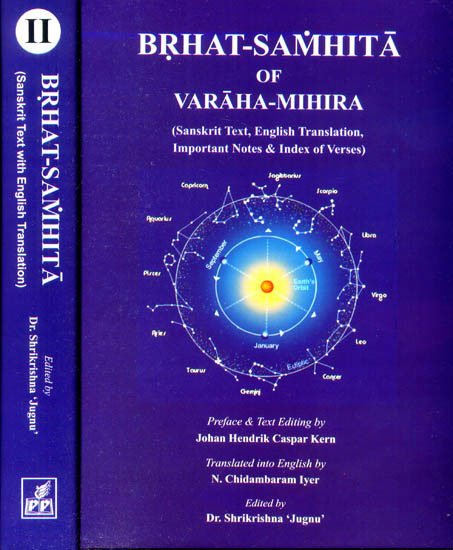Brihat Samhita
by N. Chidambaram Iyer | 1884 | 135,584 words | ISBN-13: 9788171104215
This page describes planetary meetings (grahashringataka) which is the twentieth Chapter of the English translation of the Brihat-samhita. This work, written by Varahamihira in the 6th century, is classified as jyotisha literature, also known as Indian astronomy. It contains however, also content regarding astrology, palmistry, agriculture, gardening, perfumes, medicines and various other encyclopedic topics.
Chapter 20 - On planetary meetings (grahaśṛṅgāṭaka)
[Sanskrit text for this chapter is available]
Note: This refers to the apparent geometrical figures formed by the meeting of planets.
1. People living in that quarter of the earth will suffer from weapons, from hunger and from other miseries in which direction a planet reappears after, or disappears by, its conjunction with the Sun.[1]
2. If when the planets meet so as to form a circle, a bow, a triangle, a rod, a citadel, a lance or a Vajrāyuddha[2], mankind will suffer from starvation, from drought and from war.[3]
3. The rulers of those parts of the earth will suffer from foreign invasions and be dispossessed of their countries by foreign princes which correspond to the quarters of the heavens in which the several planets are seen to meet as described above towards night-fall.[4]
4. The objects and persons represented by the several asterisms in which the planets happen to meet will suffer; but if the discs of the planets should be bright and apart from one another there will be happiness in the land.
5. Planetary meetings are of five sorts known technically as—l. Saṃvarta, 2. Samāgama, 3. Sammoha, 4. Samāja, 5. Sannipāta and 6. Kośa. We will now define these and state their effects.
6. If in a single sign, Paura planets and Yāyin planets should meet together to the number of 4 or 5, the meeting is known as Saṃvana. If either Rāhu or Ketu should join them the meeting is known as Sammoha,
7. If, in a single sign, there should meet either Paura planets or Yāyin planets, in either case the meeting is known as Samāja. If when Saturn and Jupiter meet, some other planets should join them, the meeting is known as Kośa.[5]
8. The meeting of a planet which reappears in the west with another planet which reappears in the east, after their conjunction with the Sun is known as Sannipāta. If the meeting planets should suffer no change in their nature and should appear bright and of large size, the meeting is known as Samāgama. There will then be prosperity in the land.
9. The effects of the Saṃvarta and Samāgama meetings are indifferent, i.e. there will be neither much of prosperity nor much of adversity. The effects of the Sammoha and Kośa meetings are disastrous in their character; in the Samāja meeting there will be an equal degree of prosperity and adversity. And in the Sannipāta meeting, mankind will be at war with one another.
Footnotes and references:
[1]:
This accords with the opinion of Kaśyapa.
[2]:
Vajrāyuddha: a three edged weapon narrow at the middle and broad at both ends.
[3]:
Kaśyapa says that if the planets meet in other than certain well-known figures, mankind will be happy.
[4]:
Lines drawn from Madhyadeśa and from the Zenith to the eight points of the compass will divide both the Earth and the Sky into eight equal parts and the Madhyadeśa will correspond to mid-heaven.
[5]:
This accords with the opinion of Bādarāyaṇa; but according to Parāśara if when Jupiter and one or two other planets meet, Saturn should join them, the meeting is known as Kośa.
